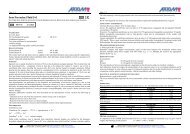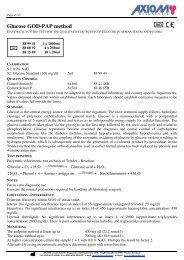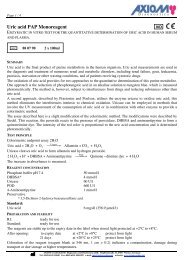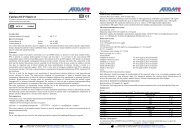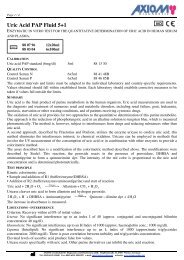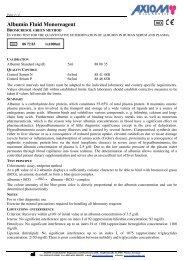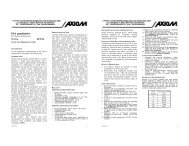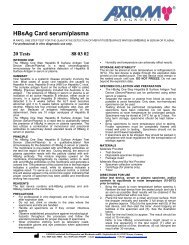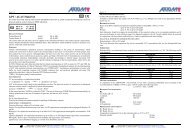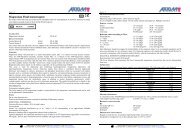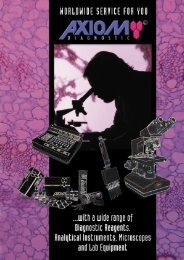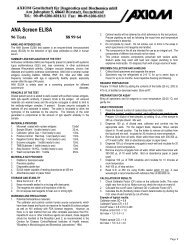Chloride monoreagent 88 72 72 - AXIOM Solutions
Chloride monoreagent 88 72 72 - AXIOM Solutions
Chloride monoreagent 88 72 72 - AXIOM Solutions
Create successful ePaper yourself
Turn your PDF publications into a flip-book with our unique Google optimized e-Paper software.
Page 1 / 4<br />
D I A G N O S T I C<br />
Page 2 / 4<br />
D I A G N O S T I C<br />
!<br />
<strong>Chloride</strong> Fluid Monoreagent<br />
IN VITRO TEST FOR THE QUANTITATIVE DETERMINATION OF CHLORIDE IN HUMAN SERUM, PLASMA<br />
AND URINE BY THIOCYANATE METHOD<br />
REF<br />
RE<br />
F<br />
<strong>88</strong> <strong>72</strong> <strong>72</strong> 2x100ml<br />
CALIBRATION<br />
<strong>Chloride</strong> standard (100mmol/l) 5ml <strong>88</strong> 19 21<br />
QUALITY CONTROL<br />
Control Serum N 6x5ml <strong>88</strong> 41 48B<br />
Control Serum P 6x5ml <strong>88</strong> 46 85B<br />
The control intervals and limits must be adapted to the individual laboratory and country-specific requirements.<br />
Values obtained should fall within established limits. Each laboratory should establish corrective measures to be<br />
taken if values fall outside the limits.<br />
SUMMARY<br />
<strong>Chloride</strong> is the most abundant extracellular anion. Together with natrium chloride is responsible for the<br />
maintenance of osmotic pressure, the anion-cation balance and therefore of the water distribution in the<br />
extracellular fluid compartment. Decreased plasma Cl - -concentrations (hypochloremia) can result from salt-losing<br />
nephritis, persistent gastric secretion, prolonged vomiting and metabolic acidosis that are caused by increased<br />
production or reduced secretion of organic acids. Increased plasma Cl - -concentrations (hyperchloremia) occur<br />
with dehydration, renal tubular acidosis, acute renal failure, in adrenocortical hyperfunction , salicylate<br />
intoxication and metabolic acidosis associated with prolonged diarrhoea and loss of sodium bicarbonate. <strong>Chloride</strong><br />
is often analyzed in combination with sodium and potassium to determine the anion gap in serum and/or urine.<br />
The urinary anion gap is useful in the initial evaluation of hyperchloremic metabolic acidosis. Due to the different<br />
reactivity equivalents of chloride and bromide the thiocyanate method is less disturbed by the presence of<br />
bromide than measurement with an ion-selective electrode.<br />
TEST PRINCIPLE<br />
<strong>Chloride</strong> ions and Hg II – thiocyanate form thiocyanate ions in acidic medium.<br />
These ions react with HNO 3 and FE III – ions and effect a red colour. The increasing extinction is directly<br />
proportional to the concentration of chloride ions.<br />
2 Cl - + Hg(SCN) 2 "#<br />
HgCl 2<br />
+ 2SCN $<br />
2SCN $ + Fe 3+ "#<br />
Fe(SCN) 2+<br />
NOTES<br />
For in vitro diagnostic use.<br />
Exercise the normal precautions required for all laboratory reagents. Contains mercuric thiocyanate.Toxic,<br />
harmful if inhaled or absorbed through skin. Consider local disposal regulations.<br />
LIMITATIONS - INTERFERENCE<br />
Criterion: Recovery within ±10% of initial value.<br />
Icterus: No significant interference up to a bilirubin concentration of 30 mg/dl.<br />
Hemolysis: No significant interference up to a haemoglobin concentration of 1000 mg/dl.<br />
Lipemia (Intralipid): No significant interference up to a triglyceride concentration of 400 mg/dl.<br />
MEASURING/REPORTABLE RANGE<br />
As mentioned before urine has to be diluted threefold with aqua dist.<br />
If measured values exceed the linear range from 1 – 130 mmol/l dilute the sample 1+1 with the identical volume<br />
aqua dest. and multiply the result by a factor of 2.<br />
IVD<br />
EXPECTED VALUES<br />
Serum:<br />
97 – 108 mmol/l<br />
Urine : 24 h urine 95 – 240 mmol/24h<br />
morning urine<br />
54 – 158 mmol/l<br />
Conversion between conventional and SI units: 1 mEq/l = 1 mmol/l<br />
Conversion between mmol/ and mg/dl: mmol/l = 0.282 x mg/dl<br />
Each laboratory should investigate the transferability of the expected values to its own patient population and if<br />
necessary determine its own reference range.<br />
For diagnostic purposes the chloride results should always be assayed in conjunction with the patient’s medical<br />
history, clinical examinations and other findings.<br />
IMPRECISION<br />
Reproducibility was determined using samples in an internal protocol. The following results were obtained.<br />
Within run<br />
Sample Mean mg/gl SD mg/dl CV %<br />
Sample 1 102.04 0.80 0.78<br />
Sample 2 104.15 0.75 0.66<br />
Sample 3 113.15 0.75 0.<strong>72</strong><br />
Between run<br />
Sample Mean mg/gl SD mg/dl CV %<br />
Sample 1 101.32 1.28 1.26<br />
Sample 2 103.03 1.13 1.10<br />
Sample 3 105.83 1.43 1.35<br />
REAGENT CONCENTRATION<br />
R1:<br />
Hg – II - thiocyanate<br />
Fe – III - nitrate<br />
HNO3<br />
2 mmol/l<br />
30 mmol/l<br />
40 mmol/l<br />
PREPARATION AND STABILITY<br />
All reagents are ready to use.<br />
Protect from direct sunlight.<br />
Stable up to the expiry date when stored at +2°C to +8°C.<br />
SPECIMEN<br />
Serum<br />
Separate serum from the clot and cells within 45 min.<br />
Urine<br />
Urine has to be diluted 1+2 with distilled water. Multiply result by 3. Centrifuge samples containing precipitate<br />
before performing the assay.<br />
TESTING PROCEDURE<br />
• Working solutions as described above<br />
Additional materials required<br />
• Calibrators and controls as indicated below<br />
• 0.9% NaCl<br />
<strong>AXIOM</strong> Gesellschaft für Diagnostica und Biochemica mbH; Siegfriedstraße 14, 67547 Worms, Germany<br />
Tel.: 0049-6241-50040 Fax: 0049-6241-5004499 e-mail: info@axiom-online.net webseite: www.axiom-online.net<br />
<strong>AXIOM</strong> Gesellschaft für Diagnostica und Biochemica mbH; Siegfriedstraße 14, 67547 Worms, Germany<br />
Tel.: 0049-6241-50040 Fax: 0049-6241-5004499 e-mail: info@axiom-online.net webseite: www.axiom-online.net
Page 3 / 4<br />
D I A G N O S T I C<br />
Page 4 / 4<br />
D I A G N O S T I C<br />
!<br />
Manual procedure:<br />
Wavelength<br />
Temperature<br />
Cuvette<br />
Zero adjustment<br />
Hg 492 nm (460 – 500 nm)<br />
+25°C / +30°C / +37°C<br />
1cm light path<br />
against reagent blank<br />
blank Standard / Calibrator Sample<br />
Working reagent 1000 µl 1000 µl 1000 µl<br />
Standard --- 10 µl ---<br />
Sample --- --- 10 µl<br />
Mix and after 5 minutes read absorbance of sample and standard against reagent blank. Determine the<br />
absorbance change as<br />
!A sample = (A sample – A blank)<br />
!A standard = (A standard – A blank)<br />
and use this for the calculation.<br />
Calculation:<br />
"Asample<br />
x standard conc. = <strong>Chloride</strong> conc. (mmol/l)<br />
"Astandard<br />
<strong>Chloride</strong> concentration is calculated using the <strong>Chloride</strong> concentration is calculated using the supplied standard<br />
(100 mmol/l = 354.6 mg/dl). Linearity is up to 130 mmol/l (462 mg/dl)<br />
Temperature permanency throughout the measurement is extremely important!<br />
DISPOSAL<br />
Please note the legal regulations.<br />
LITERATURE<br />
1. Bablok W. et al. A General Regression Procedure for Method Transformation. J Clin Chem Clin Biochem 19<strong>88</strong>;26:783-790.<br />
2. Batlle DC. et al. The use of the urinary anion gap in the diagnosis of hyperchloremic metabolic acidosis.<br />
N Engl J Med 19<strong>88</strong>, 318:594-599.<br />
3. Krieg M. et al. Comparative quantitative clinico-chemical analysis of the characteristics of 24-hour urine and morning urine<br />
(in German). J Clin Chem Clin Biochem 1986, 24:863.<br />
4. Passing H., Bablok W. A New Biometrical Procedure for Testing the Equality of Measurements from Two Different Analytical<br />
Methods. J Clin Chem Clin Biochem 1983;21:709-<strong>72</strong>0.<br />
5. Schönfeld, RG. Lewellen, CJ. A colorimetric method for determination of serum chloride. Clin Chem., 10, 533 (1964)<br />
6. Tietz N.W. Clinical Guide to Laboratory Tests, 3rd Philadelphia: W.B. Saunders Company, 1995:516-519.<br />
<strong>AXIOM</strong> Product range Clinical Chemistry<br />
Enzymes Ions Other Metabolites<br />
Acid Phosphatase Ammonium fluid Bilirubin T/D<br />
Alkaline Phosphatase Copper fluid Creatinine fluid<br />
!-Amylase direct Calcium fluid Glucose GOD-PAP fluid<br />
CK-NAC actived <strong>Chloride</strong> fluid Glucose Hexokinase fluid<br />
CK-MB (NAC- actived) Inorganic Phosphorus UV fluid Urea Enzymatic fluid<br />
"-GT fluid Iron fluid Urea UV fluid<br />
LDH fluid TIBC Uric Acid PAP fluid<br />
Cholinesterase<br />
Magnesium fluid<br />
GOT/ASAT fluid<br />
Potassium fluid<br />
GPT/ALAT fluid<br />
Sodium fluid<br />
Controls<br />
Lipase UV fluid<br />
Control Serum N<br />
Lactate PAP<br />
Control Serum P<br />
Proteins<br />
!-HBDH<br />
Lipids<br />
Albumin<br />
CSF-Protein fluid<br />
Cholesterol fluid<br />
Microprotein fluid<br />
HDL Cholesterol<br />
Hemoglobin<br />
LDL Cholesterol<br />
Protein Total fluid<br />
Triglycerides fluid<br />
<strong>AXIOM</strong> Gesellschaft für Diagnostica und Biochemica mbH; Siegfriedstraße 14, 67547 Worms, Germany<br />
Tel.: 0049-6241-50040 Fax: 0049-6241-5004499 e-mail: info@axiom-online.net webseite: www.axiom-online.net<br />
06/09 M/kd<br />
<strong>AXIOM</strong> Gesellschaft für Diagnostica und Biochemica mbH; Siegfriedstraße 14, 67547 Worms, Germany<br />
Tel.: 0049-6241-50040 Fax: 0049-6241-5004499 e-mail: info@axiom-online.net webseite: www.axiom-online.net



